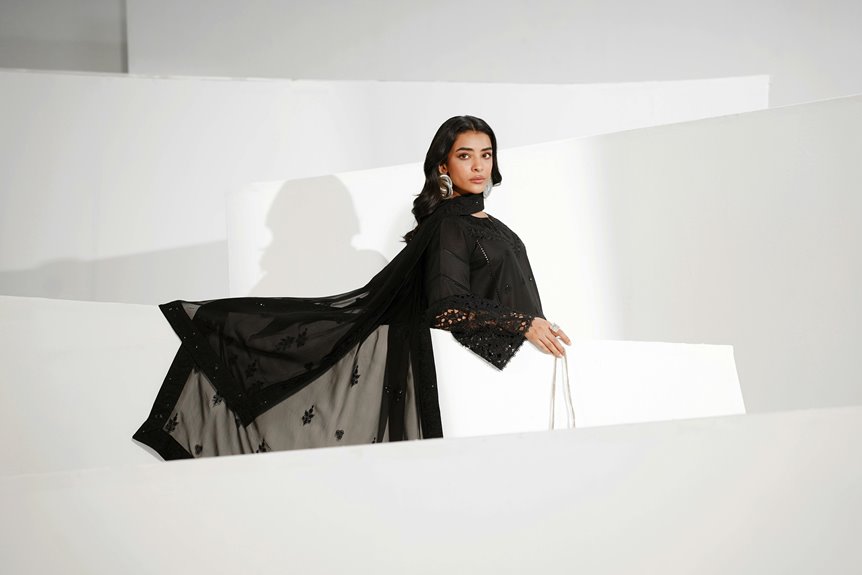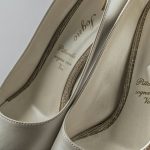You’ll find gabardine and poplin differ mainly in weave and feel. Gabardine uses a tight twill weave that’s durable, smooth, and holds shape well—perfect for tailored suits and outerwear. Poplin’s plain weave is lighter, crisp, and breathable, making it great for shirts and casual wear. Gabardine costs more but lasts longer; poplin is budget-friendly and softer. If you want to know how these factors affect comfort, care, and fashion uses, keep exploring.
Table of Contents
Key Takeaways
- Gabardine features a tight twill weave with diagonal ribs, while poplin has a plain weave with a crisp, smooth texture.
- Gabardine is durable, wrinkle-resistant, and suited for structured garments; poplin is lightweight, breathable, and ideal for casual wear.
- Gabardine holds shape well and is pricier due to dense weaving; poplin drapes fluidly and is generally more affordable.
- Gabardine is commonly used for suits and outerwear, whereas poplin is popular for dress shirts and summer clothing.
- Maintenance differs as gabardine tolerates gentle machine washing, while poplin may require more frequent ironing and delicate care.
What Is Gabardine Fabric?
Gabardine fabric is a tightly woven material known for its durability and smooth finish. When you choose gabardine, you’re opting for a fabric with a distinctive twill weave, which gives it diagonal ribs on the surface.
This construction makes it resistant to wrinkles and wear, so it holds up well over time. You’ll often find gabardine made from wool, cotton, or synthetic fibers, each offering different levels of breathability and warmth.
Because of its strength and smooth texture, gabardine is popular for tailored garments like suits, trousers, and outerwear. If you need a fabric that combines elegance with practicality, gabardine fits the bill perfectly, providing a crisp, polished look that doesn’t sacrifice comfort or longevity.
What Is Poplin Fabric?
While gabardine offers a sturdy, twill weave with a smooth finish, poplin stands out with its plain weave and crisp texture.
Gabardine features a sturdy twill weave, while poplin is known for its crisp plain weave texture.
When you choose poplin, you’re picking a lightweight, breathable fabric that feels cool against your skin, making it ideal for warm weather. It’s often made from cotton or a cotton blend, which adds to its softness and comfort.
You’ll find poplin in dress shirts, summer dresses, and casual wear because of its smooth surface and slight sheen.
Poplin resists wrinkles better than many other cotton fabrics, so it keeps your look sharp throughout the day.
If you want a fabric that’s both durable and comfortable, poplin’s straightforward weave and fine yarns will work well for your everyday wardrobe.
Weave Patterns and Construction Differences
Because each fabric’s weave affects its texture and durability, understanding their construction helps you choose the right one for your needs.
Gabardine uses a tight twill weave, which creates diagonal lines and a sturdy, durable surface. Poplin, on the other hand, features a plain weave with a simple over-under pattern, making it lightweight and smooth.
Here’s how they differ:
- Gabardine’s twill weave gives it strength and resistance to wrinkles.
- Poplin’s plain weave results in a balanced, crisp fabric with less texture.
- Gabardine’s tight construction makes it more suited for structured garments, while poplin’s openness offers breathability.
Knowing these differences guarantees you pick the fabric that fits your project perfectly.
Texture and Feel Comparison
Although both fabrics serve different purposes, you’ll notice distinct differences in their texture and feel that influence how they wear. Gabardine offers a smooth, tightly woven surface with a slight diagonal rib, giving it a firm yet comfortable hand. Poplin feels lighter and softer, with a crisp, flat surface that feels invigorating on your skin. These tactile contrasts affect your comfort and garment style choices.
| Fabric | Texture & Feel |
|---|---|
| Gabardine | Smooth, dense, slight ribbed feel |
| Poplin | Soft, crisp, lightweight |
| Gabardine | Structured, holds shape well |
| Poplin | Breathable, drapes fluidly |
Choosing between them means balancing structure with softness based on your needs.
Durability and Maintenance
When you choose between gabardine and poplin, consider how each fabric stands up to wear and care. Gabardine, known for its tightly woven structure, offers excellent durability and resists wrinkles better than poplin.
Poplin, while lighter, demands more gentle handling to maintain its crisp look. Here’s what to keep in mind:
- Gabardine: It’s tougher, resists abrasions, and holds shape well, making it easier to maintain with regular machine washing on gentle cycles.
- Poplin: It’s prone to creasing and may require frequent ironing; hand washing or delicate machine cycles are best.
- Both fabrics: Avoid high heat drying to prevent damage, and always check care labels to prolong fabric life.
Understanding these maintenance needs helps you keep your garments looking sharp longer.
Typical Uses in Fashion and Tailoring
You’ll find gabardine often used for structured suits and outerwear, while poplin suits lighter shirts and dresses.
Tailors prefer gabardine for sharp, durable styles and poplin for breathable, casual looks.
Choosing between them usually depends on the season and the garment’s purpose.
Common Garment Applications
Fabric choice plays an essential role in determining the style and function of your garments. When deciding between gabardine and poplin, knowing their common applications can guide you to the right fabric for your project.
Gabardine’s tightly woven structure makes it ideal for pieces that need durability and a sharp appearance. Poplin’s lighter, smoother texture suits breathable, comfortable clothing.
Here’s where each fabric shines:
- Gabardine: Perfect for tailored suits, outerwear, and trousers that demand structure.
- Poplin: Great for dress shirts, blouses, and lightweight summer dresses offering ease and breathability.
- Both fabrics: Work well in uniforms and casual wear, depending on the desired finish and climate.
Choosing wisely guarantees your garment meets both style and practical needs.
Tailoring Preferences and Styles
Understanding where gabardine and poplin are commonly used sets the stage for exploring how their unique qualities influence tailoring preferences and styles.
When you choose gabardine, you’re opting for a fabric that holds structure well, making it ideal for sharply tailored suits, trousers, and outerwear. Its smooth, tightly woven surface offers a polished, professional look, perfect for formal wear.
On the other hand, poplin’s lighter, softer texture suits more casual or semi-formal pieces like dress shirts and lightweight dresses. If you want garments that drape fluidly with breathable comfort, poplin is your go-to.
Tailors often select gabardine for pieces requiring durability and form, while poplin suits designs emphasizing ease and movement. Knowing these differences helps you pick the right fabric to match your style and garment function.
Seasonal Suitability Choices
When should you reach for gabardine versus poplin during different seasons? Choosing the right fabric depends on comfort and style throughout the year. Here’s how to decide:
- Winter and Fall: Gabardine’s tight weave and heavier weight keep you warm, making it ideal for suits and outerwear in colder months.
- Spring and Summer: Poplin’s lightweight, breathable nature helps you stay cool, perfect for shirts and lighter suits in warmer weather.
- Transitional Seasons: You can layer poplin shirts under gabardine blazers for a balanced outfit that adapts to fluctuating temperatures.
Seasonal Suitability and Comfort
Because gabardine is tightly woven and heavier, you’ll find it ideal for cooler months, offering warmth without sacrificing breathability. It feels sturdy against your skin, helping you stay comfortable when temperatures drop.
On the other hand, poplin’s lightweight, plain weave makes it perfect for warmer weather. You’ll appreciate how it keeps you cool and allows air to circulate, preventing that sticky, overheated feeling.
When you wear gabardine, you get durability and insulation; with poplin, you enjoy softness and ventilation. Both fabrics serve different seasonal needs, so picking the right one depends on when you’ll wear your suit.
Price and Availability Considerations
Choosing between gabardine and poplin isn’t just about comfort and seasonality; price and availability also play a big role.
Price and availability are key factors alongside comfort and season when choosing between gabardine and poplin.
When deciding which fabric suits your needs, consider these factors:
- Cost Difference: Gabardine tends to be pricier due to its dense weave and durability, while poplin is generally more affordable, making it a budget-friendly option.
- Accessibility: Poplin is widely available in various blends and colors, so you’ll find it easily at most fabric stores. Gabardine can be less common, especially in high-quality wool blends.
- Suitability for Projects: If you want a durable, long-lasting garment, investing in gabardine might be worth it. For lighter, everyday wear, poplin offers great value without compromising style.
Balancing these points will help you pick the fabric that fits both your wallet and wardrobe.
Frequently Asked Questions
Can Gabardine and Poplin Fabrics Be Blended Together?
You can definitely blend gabardine and poplin fabrics to combine their strengths. This mix offers durability and smoothness, perfect for versatile clothing. Just make certain the blend suits your project’s texture and weight requirements.
Are Gabardine and Poplin Fabrics Environmentally Friendly?
Imagine choosing between two backpacks—one durable, one lightweight. Gabardine’s synthetic blends often impact the environment more, while poplin, especially cotton-based, can be greener if sourced sustainably. You’ll want to check their origins carefully.
Which Fabric Is Better for Upholstery, Gabardine or Poplin?
You’ll find gabardine better for upholstery since it’s more durable and tightly woven, resisting wear and tear. Poplin’s lighter weight makes it less suitable for heavy use, so go with gabardine for lasting furniture.
How Do Gabardine and Poplin Fabrics React to Dyeing?
Picture vibrant colors soaking into smooth, tight fibers. Gabardine absorbs dye evenly, creating deep, rich hues, while poplin’s lighter weave lets colors pop with brightness. You’ll find gabardine’s dyeing richer, poplin’s more vivid.
Are Gabardine and Poplin Suitable for Children’S Clothing?
You’ll find poplin great for kids’ clothes since it’s soft, breathable, and easy to care for. Gabardine’s durability suits outerwear, but it’s less comfy for playtime or sensitive skin, so choose wisely.
- Does Chiffon Fabric Stink - July 15, 2025
- Does Chiffon Fabric Affect the Economy - July 15, 2025
- Does Cotton Fabric Have a Nap - July 15, 2025







